Klingertdt versus КлингАрт
Klingertdt versus КлингАрт
I'd like to start a discussion (it is too quiet here nowadays...)
The more I research the more frustrated I get. More knowledge causes more pain... various sources give various answers and sometimes even contradictory ones. I have started to doubt whether Gustav Klingerdt really used a mark КЛИНГАРТ using an A instead of an E. I have not managed to see such a mark in reality. Can anybody show a picture of this mark (and the object)? Moreover, if there was an A in the respective mark, what might have been the reason for that? Why not simply КЛИНГЕРТ like the Latin version KLINGERT?
In addition, some sources claim that he started to use his Cyrillic initials ГК in the beginning of his period but after about 1890-1899 his Latin ones GK. Did he? Please note that Klingert's GK mark resembles very much another known master i.e. Semen Kasakov's mark active at about the same time in Moscow. They are often mixed.
In addition, did he at some point work with Fabergé and was his production for sale in Fabergé's showroom in Moscow or is all this something that somebody once upon a time "thought" was a fact and has now become the "truth"?
In case of somebody misunderstanding my text above (it happens), I am not claiming anything, just asking what might have been the truth and based on what? It would be interesting to have at least something verified or overruled!
Can't hardly wait for your interesting responses and comments!
The more I research the more frustrated I get. More knowledge causes more pain... various sources give various answers and sometimes even contradictory ones. I have started to doubt whether Gustav Klingerdt really used a mark КЛИНГАРТ using an A instead of an E. I have not managed to see such a mark in reality. Can anybody show a picture of this mark (and the object)? Moreover, if there was an A in the respective mark, what might have been the reason for that? Why not simply КЛИНГЕРТ like the Latin version KLINGERT?
In addition, some sources claim that he started to use his Cyrillic initials ГК in the beginning of his period but after about 1890-1899 his Latin ones GK. Did he? Please note that Klingert's GK mark resembles very much another known master i.e. Semen Kasakov's mark active at about the same time in Moscow. They are often mixed.
In addition, did he at some point work with Fabergé and was his production for sale in Fabergé's showroom in Moscow or is all this something that somebody once upon a time "thought" was a fact and has now become the "truth"?
In case of somebody misunderstanding my text above (it happens), I am not claiming anything, just asking what might have been the truth and based on what? It would be interesting to have at least something verified or overruled!
Can't hardly wait for your interesting responses and comments!
Re: Klingertdt versus КлингАрт
Hi,
Klingart with A is a mystery.
This is Klingert`s signature in Cyrilic; obviously Klingert.Besides,there is no German name Klingart, not even "Umlaut-A".
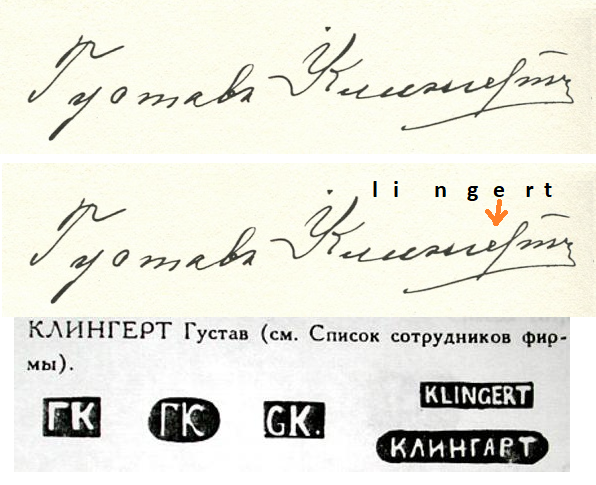
In regard of Faberge, this is a Russian source:
https://lermontovgallery.ru/spravochnik ... tavovicha/
One of the sons was an accountant for Faberge Moscow branch.
That`s all I can tell.
Kindest regards
Klingart with A is a mystery.
This is Klingert`s signature in Cyrilic; obviously Klingert.Besides,there is no German name Klingart, not even "Umlaut-A".

In regard of Faberge, this is a Russian source:
https://lermontovgallery.ru/spravochnik ... tavovicha/
Rukkert and Klingert were considered the best enamellers of the capital, their workshops fulfilled many orders for Faberge.Лучшими эмальерами столицы считались Рюккерт и Клингерт, их предприятия выполнили немало заказов для Фаберже.
One of the sons was an accountant for Faberge Moscow branch.
That`s all I can tell.
Kindest regards
Re: Klingertdt versus КлингАрт
Hi -
those who are interested in Russian silver / enamel should primarily do their "homework". Marks are the one - orignal pieces are the other. More important than marks that may have changed over the years are the work, quality and color scheme of each artist. For a savvy one, it is not possible to confuse Klingert's work with Kasakov's work!
This is especially true for the increasingly massive and better-made fakes.
The savvy man does not miss any of the numerous mistakes - he knows where and what to look.
Some fake marks:

Some Kasakov objects:


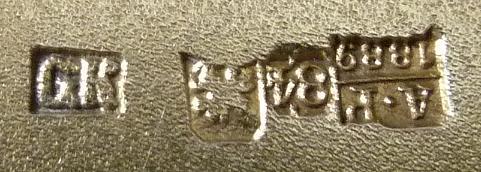

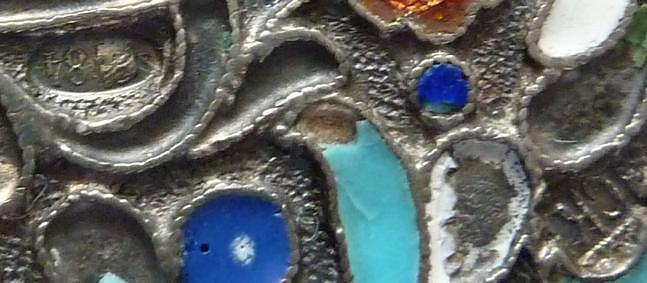
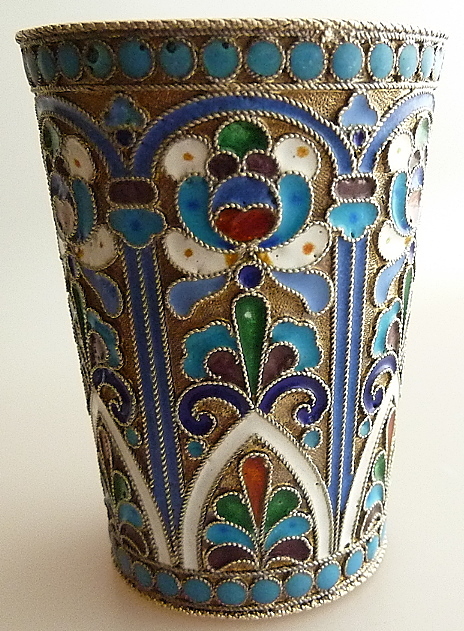
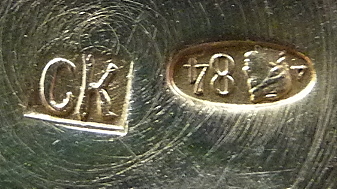


Some Klingert object:




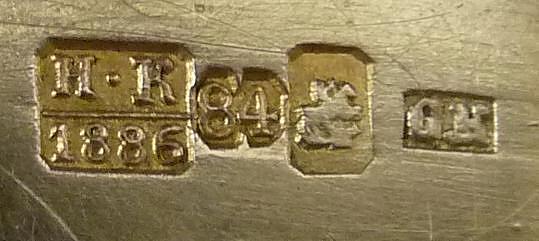



And the never ending fakeproduction....so beware!

Regards
Goldstein
those who are interested in Russian silver / enamel should primarily do their "homework". Marks are the one - orignal pieces are the other. More important than marks that may have changed over the years are the work, quality and color scheme of each artist. For a savvy one, it is not possible to confuse Klingert's work with Kasakov's work!
This is especially true for the increasingly massive and better-made fakes.
The savvy man does not miss any of the numerous mistakes - he knows where and what to look.
Some fake marks:

Some Kasakov objects:









Some Klingert object:








And the never ending fakeproduction....so beware!

Regards
Goldstein
Re: Klingertdt versus КлингАрт
Hi AG2012 -
Regards
Goldstein
Nice collection of fakes....AG2012 wrote:https://lermontovgallery.ru/spravochnik ... tavovicha/
Regards
Goldstein
Re: Klingertdt versus КлингАрт
Just for the record, and as side-note to the topic, not mentioned in the clipping Goldstein posted is the fact that Klingert also exhibited at the Tennessee Centennial Exposition; May 1 - October 30, 1897.
The official report noting: Gustav Klingert, care Russian Silversmith Company, Moscow, Russia – Art silverware, enameled. This is a very creditable exhibit, and well illustrates Russian silversmithing.
Source: Official History of the Tennessee Centennial Exposition - Edited by Herman Justi - 1898
Trev.
The official report noting: Gustav Klingert, care Russian Silversmith Company, Moscow, Russia – Art silverware, enameled. This is a very creditable exhibit, and well illustrates Russian silversmithing.
Source: Official History of the Tennessee Centennial Exposition - Edited by Herman Justi - 1898
Trev.
Re: Klingertdt versus КлингАрт
@Goldstein
Thank you but it is not necessary to show me extracts from Ivanov. I have had his books for years and know what is written in them. The question is still: Where from is the information that Klingert worked with Fabergé? I also wrote that when something incorrect is repeatedly repeated, it suddenly becomes the truth. Has this happened here? Moreover, you have mentioned yourself several times that Ivanov is not a fully reliable source! So, what other sources can verify it?
In addition, it is also correct that Kasakov should not be mixed with Klingert but it happens one time after the other. It is unbelievable how many times I have tried to correct sellers, auction houses etc. but with poor result.
The other questions is as well still open i.e. where from comes the mark КЛИНГАРТ? AG2012 was kind enough to show a soot mark, but I would like to see an original mark and the object where it is punched. Thank you in advance.
Thank you but it is not necessary to show me extracts from Ivanov. I have had his books for years and know what is written in them. The question is still: Where from is the information that Klingert worked with Fabergé? I also wrote that when something incorrect is repeatedly repeated, it suddenly becomes the truth. Has this happened here? Moreover, you have mentioned yourself several times that Ivanov is not a fully reliable source! So, what other sources can verify it?
In addition, it is also correct that Kasakov should not be mixed with Klingert but it happens one time after the other. It is unbelievable how many times I have tried to correct sellers, auction houses etc. but with poor result.
The other questions is as well still open i.e. where from comes the mark КЛИНГАРТ? AG2012 was kind enough to show a soot mark, but I would like to see an original mark and the object where it is punched. Thank you in advance.
Re: Klingertdt versus КлингАрт
This is from a Russian forum, no reference for what`s claimed,though.
All orders for Fedor Rukert from Faberge proceeded formally, by sending sketches with inventory numbers and passed through the accounts department and paid on the basis of the estimates and accounts of Rukert with the number of materials and means used.
Such a system of calculations existed with all the workshops that did not work in the same building of the firm, for example, with M. Perkhin with F. Rukert and others.
Part of the archives, including sketches by Karl Faberge himself, survived.
There is not a single piece of paper and even a small account to confirm any cooperation with Klingert's workshop.
Re: Klingertdt versus КлингАрт
Hi Qrt.S -
my personal advice: leave your books and visit famous and not so famous auction houses international. There you can see that famous names (correct or not correct spelled) objects with phantasy designs, colours, styles are sold for very much money - every day.
If you can not afford to travel - eBay is also an enlightening field - you can use it from home.
Then start correcting the whole world - they wait for you!
Regards
Goldstein
my personal advice: leave your books and visit famous and not so famous auction houses international. There you can see that famous names (correct or not correct spelled) objects with phantasy designs, colours, styles are sold for very much money - every day.
If you can not afford to travel - eBay is also an enlightening field - you can use it from home.
Then start correcting the whole world - they wait for you!
Regards
Goldstein
Re: Klingertdt versus КлингАрт
@Goldstein,
I don't need your advice, keep it for yourself. You have no idea of how much I travel and where I visit and or what I see.
I don't need your advice, keep it for yourself. You have no idea of how much I travel and where I visit and or what I see.
Re: Klingertdt versus КлингАрт
@AG2012
Thank you, very interesting but in conflict with the earlier quotation: "Rukkert and Klingert were considered the best enamellers of the capital, their workshops fulfilled many orders for Faberge." , so what is the truth?AG2012 wrote:This is from a Russian forum, no reference for what`s claimed,though.All orders for Fedor Rukert from Faberge proceeded formally, by sending sketches with inventory numbers and passed through the accounts department and paid on the basis of the estimates and accounts of Rukert with the number of materials and means used.
Such a system of calculations existed with all the workshops that did not work in the same building of the firm, for example, with M. Perkhin with F. Rukert and others.
Part of the archives, including sketches by Karl Faberge himself, survived.
There is not a single piece of paper and even a small account to confirm any cooperation with Klingert's workshop.
Re: Klingertdt versus КлингАрт
I opt for the latter statement. Lermontov galleries are online antique dealers, sometimes offering questionable objects in regard of authenticity.
Besides,Ulla Tillander does not mention Klingert, either, and her list of masters and subcontractors looks comprehensive (e.g Andrei Gorianov and Wilhelm Reimer, less known than Klingert).
Regards
Besides,Ulla Tillander does not mention Klingert, either, and her list of masters and subcontractors looks comprehensive (e.g Andrei Gorianov and Wilhelm Reimer, less known than Klingert).
Regards
Re: Klingertdt versus КлингАрт
I have spoken with Ulla T-G many times and also discussed this "problem" with her. She is very doubtful about this co-operation Fabergé but is as for now unable to show any evidence of an existing business relationship or not.
Re: Klingertdt versus КлингАрт
Hi -
A truly sibylline answer - if the conversation ever took place in this form - not "yes", not "no" - not even "maybe" or "I do not know" ..... Simply nothing!
Fabergé was first and foremost a businessman/merchant - especially in Moscow - Moscow could not keep up with the opportunities in St. Petersburg. Hence the many subcontractors we do not know from St. Petersburg. Who they really were was deliberately veiled by the removal (with a few exceptions) of their marks. A custom that is still used today by clever people who can count.
Fabergé is not only one of the purveyors of the tsar eggs - among other things, he supplied normal silverware in Moscow - there are enough old catalogs to prove that. Even here in the forum ....
There is much fog - many stories and rumors - few facts - but also much was simply forgotten.
Maybe one day a file note appears in which Klingert rejects a collaboration with Fabergé vehemently?
Regards
Goldstein
Aha!!!Qrt.S wrote:I have spoken with Ulla T-G many times and also discussed this "problem" with her. She is very doubtful about this co-operation Fabergé but is as for now unable to show any evidence of an existing business relationship or not.
A truly sibylline answer - if the conversation ever took place in this form - not "yes", not "no" - not even "maybe" or "I do not know" ..... Simply nothing!
Fabergé was first and foremost a businessman/merchant - especially in Moscow - Moscow could not keep up with the opportunities in St. Petersburg. Hence the many subcontractors we do not know from St. Petersburg. Who they really were was deliberately veiled by the removal (with a few exceptions) of their marks. A custom that is still used today by clever people who can count.
Fabergé is not only one of the purveyors of the tsar eggs - among other things, he supplied normal silverware in Moscow - there are enough old catalogs to prove that. Even here in the forum ....
There is much fog - many stories and rumors - few facts - but also much was simply forgotten.
Maybe one day a file note appears in which Klingert rejects a collaboration with Fabergé vehemently?
Regards
Goldstein
Re: Klingertdt versus КлингАрт
For the world completely unknown mighty Mr. Goldstein has questioned a famous experts opinion. Only Mr. Goldstein knows it all!!!
Halleluja, halleluja, halleluja, amen. No need for further discussions. Case closed.
Halleluja, halleluja, halleluja, amen. No need for further discussions. Case closed.